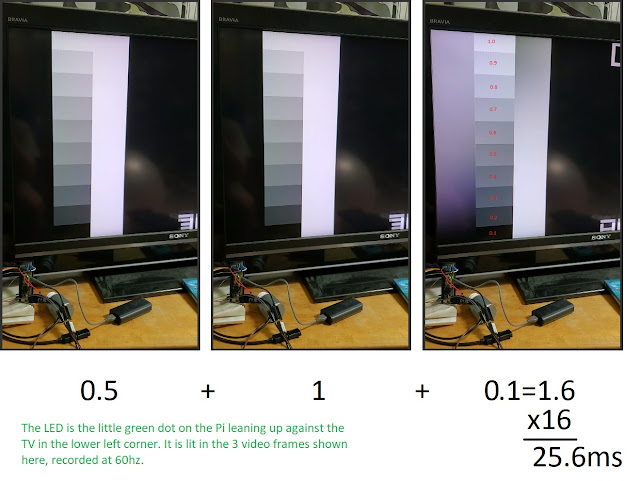Sharp LC-C3234U TV review: input lag and upscaling tested using the piLagTesterPRO
This 720p TV from 2009 retailed for around $800. It is good at upscaling 480i/p but has average to below average input lag.
Overview/Image quality
It has all the standard inputs, including 2 HDMI, VGA, and 2 yPbPr. All test results were identical for HDMI and VGA.
Input Lag and video sync issues
This display does not have a game mode; not even a game 'color' preset. There is a game timer, which apparently keeps track of how long you've been playing games. "Cute".What other video settings the TV has made no difference on the input lag.
I used a piLagTesterPRO to measure input lag. This device sends a frame of video over HDMI and measures how long it takes to display it.
Complicating things significantly, this is yet another display that does not actually sync to the input signal - instead it fills its own internal frame buffer from the video input and then draws that with a fixed additional delay that is randomly determined each time you turn on the set or switch inputs.
Because of the lack of proper sync each time you switch to a new input you'll get a different amount of input lag. To take one example, input lag for 720p will vary from 25ms to 42ms. What you get seems to be entirely up to chance. I've elected to report the average lag values here, since that seems fairest, but there's no right answer; for more discussion of this issue see the above link.
At least it can keep up with 60hz and 59.94hz signals correctly, so there's no dropped frames, and input lag is constant for each gaming session.
Full Test Results
I report two kinds of values. 1st response measures how long it takes for the TV to start responding (I use a 5% change in display brightness). This overly optimistic value doesn't tell how long it takes to see anything useful, but matches what other reviewers call input lag. full response is a more realistic measure of lag, and requires the display to reach 80% of full brightness. This combines both input lag and response time, and is closer to what you would actually experience in a game.Results compared to other displays
This TV is definitely below average. there's a large clump in the middle where the input lag is around 40-50ms but this set is a good 14ms slower than that. So it's definitely not for action games. It does an excellent job of upscaling so for non-action retro gaming it might be reasonable. And it's 480i performance is at least average, due to only taking 16ms to deinterlace.
Conclusion
Other models
I tested the Sharp LC-C3234U model. They also made a LC-32D44U, which should be the same, based on identical part numbers in their service manual, but I haven't checked any other sources to be sure.




Comments
Its too bad that I didn't catch your findings sooner, as I'd have been curious to see the results in game mode.
Yes I own this exact Costco-only model. I'm considering replacing it, because mine has become flaky about not powering up and flashing an error code frequently. Probably a PSU or board issue. A few years after I bought it, it started powering itself on sometimes in the middle of the night. That stopped after a while but it was probably symptomatic of some hardware issues that have turned into its current behavior.
Its unfortunate you don't have the remote. You can sort of work your way through the menus using the set-top buttons. However, it seems the only way to switch between the 7 available AV modes is using the AV mode button on the remote.
I just dug up the users manual, and the description of Game mode states "Lowers image brightness for easier viewing." And further down on the page it says "When you play games, 'GAME' is recommended for AV mode". So either they were being vague, or game mode does nothing to reduce input lag. I always felt like games were more responsive in that mode compared to the other AV modes, but maybe I was just fooling myself. If Game mode does nothing significant, I guess almost any modern TV will be a big upgrade for video gaming.